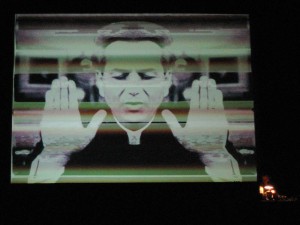For many reasons it was with trepidation that I recently accepted the position of Program Manager for the Embracing Sound [ES] Program with ANAT. Although a potentially negative opening for my initial article in the role, my trepidation is under the most positive of circumstances; primarily being the immense respect I hold for Australian sound art and its practitioners.
In mid 2006, when I learnt of the newly introduced ES program I was delighted that ANAT, a national cultural organisation, was formally recognising the sound art community and its prevalence within media art practices. Being both a practitioner and independent curator of sound orientated art practices, I will admit I also held a healthy cynicism about how the program would connect with the fiercely independent and rather disparate sound art community. Especially the community has been historically self-sustaining and somewhat on the periphery of Australia’s incredibly bureaucratic and institutionalised arts industries. With Shannon O’Neill in the role, I felt relieved an artist, writer and curator was representing our community. It is these pluralistic roles that many of us seem to operate from, and an understanding of this dynamic was imperative to connecting with and identifying the needs of the sound art community.
Sadly, due to his growing work and study commitments, Shannon could not continue in the ES role in 2008 – we are indebted to his efforts during his time in the ES position. Shannon, with his vast sound art knowledge, embarked on a research program including extensive travel to events, creating industry networks, securing project funding for the next year and advocating at a federal level. The program had a flying start with the launch of Synchresis edition of Filter and accompanying DVD, curated by Mitchell Whitelaw. While profiling some key Australian artists and a diverse range of practice approaches, these publications also address one of the primary roles of ES – to ensure considered dialogue about sound art is present in the wider music, visual and media art communities. Such promotion is particularly pertinent in challenging the conventional discipline areas of visual arts and music where the arts of sound have oft been declared irrelevant, and may be the primary reason why, for many years, experimental sound practices have been among the most under funded area of the arts.
Building on Shannon’s work I will continue his research reconnaissance by attending sound art events, from the time of writing this text in mid January to its March publication I will have already attended three events in three states. With each of these events having varying focus areas of sound, music, and media art traditions, I anticipate gaining a greater awareness of individual practitioners, collectives and (not necessarily contentious) factions within the sound arts community. During this time I am especially interested in consolidating research into artist-run-initiatives (ARIs) and analysing the fact that these organizations are an immense resource, if not the predominant vehicles for presentation and consumption of sound art in Australia. Key questions in this research will include issues of sustainability, and the pros and cons of independence under the current systems the sound arts community finds itself.
From my recent experiences of being an active participant of a sound arts oriented ARI and ongoing dialogue with members of similar organisations, my current summation is that these collectives are certainly not configured as traditional arts bureaucracies – often the roles of artist, administrator, curator and audience are profoundly blurred. Although sometimes in receipt of government funding, there are ARI’s who seem to define their own modes of operation without the constraints of conventional determinations of specific roles and genres within their organisations. Unlike ARI’s in the visual arts, ARI’s concerned with sound arts are rarely associated with a specific physical space and are consequently not bound to the conventions of gallery practice. The portability of sound art practices allows these collectives to have a flexibility of creative output that is much more concerned with encounter than object-based art. In light of the convergent world that we live in, it could be argued that these dynamics are a pertinent and immediate reflection of the huge paradigm shifts we are experiencing in the production and consumption of culture. This is a contemporaneous reflection that allows for organic, reactionary and robust processes which conventional institutions and bureaucracies are incapable of enacting.
In attempting to fulfil the requirements of the esp – which will of course also include encouraging an increased presence of quality sound oriented activities in conventional music and visual art presentation formats – I believe there is a lot to be learned from the dynamics of operation that exist within the sound community’s independent practitioners and its ARIs. When deciding to join the ANAT team I felt reassured that my colleagues didn’t see the program as an exercise in centralisation, on the contrary they too want to find ways to advocate and better support the sound community’s nuances.
Any suggestions for research areas and program needs are welcomed. Please email Sarah at: [email protected]
Read More
 This work is licensed under a Creative Commons Attribution-NonCommercial-ShareAlike 2.5 Australia.
This work is licensed under a Creative Commons Attribution-NonCommercial-ShareAlike 2.5 Australia.







